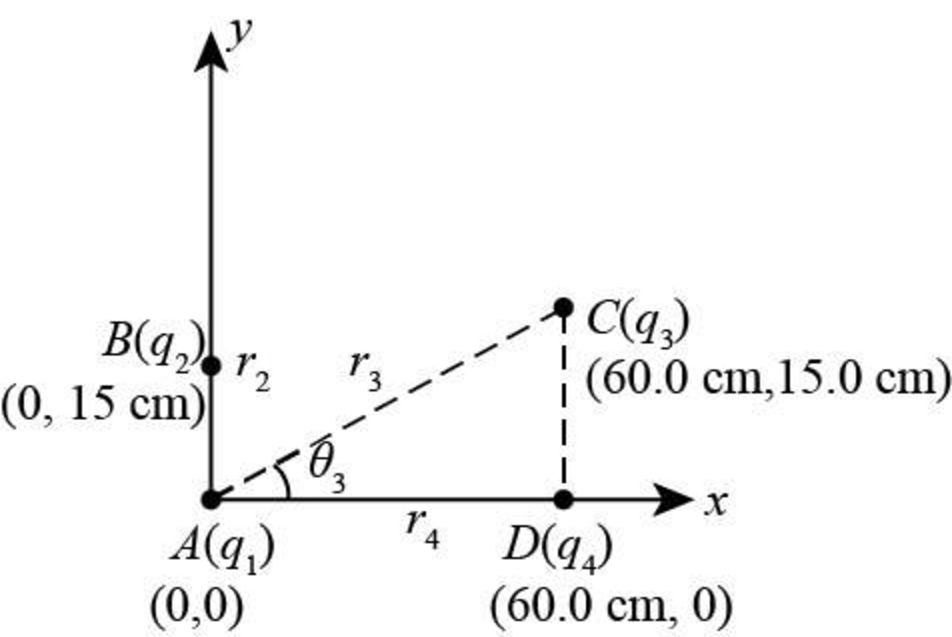
Concept explainers
(a)
The magnitude of the electric force exerted on the charge at
(a)
Answer to Problem 72AP
The magnitude of the electric force exerted on the charge at
Explanation of Solution
Write the expression for the total electric field.
Here,
Write the expression for the electric field.
Here,
Rewrite the equation (II) for resolving the forces along
Here,
Rewrite the equation (II) for resolving the forces along
Write the expression for the electric force.
Conclusion:
The following diagram shows the distance of the charges from

Figure-(1)
From the figure-(1) calculate the distance of
Consider the triangle
Consider the triangle
Substitute
Calculate further.
Substitute
Calculate further.
Substitute
Substitute
Calculate the magnitude of the electric force.
Therefore, the magnitude of the electric force exerted on the charge is
(b)
The direction of the electric force exerted on the charge at
(b)
Answer to Problem 72AP
The direction of the electric force exerted on the charge at
Explanation of Solution
Write the expression for the direction of the electric force.
Here,
Conclusion:
Substitute
Therefore, the direction of the electric force exerted on the charge is
Want to see more full solutions like this?
Chapter 23 Solutions
Physics for Scientists and Engineers with Modern, Revised Hybrid (with Enhanced WebAssign Printed Access Card for Physics, Multi-Term Courses)
- 9). A series RC circuit has a time constant of 1.0 s. The battery has a voltage of 50 V and the maximum current just after closing the switch is 500 mA. The capacitor is initially uncharged. What is the charge on the capacitor 2.0 s after the switch is closed? R 50 V a. 0.43 C b. 0 66 C c. 0.86 C d. 0.99 C Carrow_forward1). Determine the equivalent capacitance of the combination shown when C = 12 pF. +11/20 2C C Carrow_forward3). When a capacitor has a charge of magnitude 80 μC on each plate the potential difference across the plates is 16 V. How much energy is stored in this capacitor when the potential difference across its plates is 42 V? a. 1.0 mJ b. 4.4 mJ c. 3.2 mJ d. 1.4 mJ e. 1.7 mJarrow_forward
- 5). A conductor of radius r, length & and resistivity p has resistance R. It is melted down and formed into a new conductor, also cylindrical, with one fourth the length of the original conductor. The resistance of the new conductor is a. 1 R 161 b. 1 R C. R d. 4R e. 16Rarrow_forward8). Determine the magnitude and sense (direction) of the current in the 10-Q2 resistor when I = 1.8 A. 30 V L 50 V 10 Ω 20 Ω a. 1.6 A right to left b. 1.6 A left to right C. 1.2 A right to left d. 1.2 A left to right e. 1.8 A left to right R PGarrow_forward7). Determine the current in the 10-V emf. 5.0 0 w 10 V 5.0 0 15 V 5.0 Ω a. 2.3 A b. 2.7 A c. 1.3 A d. 0.30 A e. 2.5 Aarrow_forward
- 4). What is the resistance of a wire made of a material with a resistivity of 3.2 is 2.5 m and its diameter is 0.50 mm? a. 0.16 Ω b. 0.10 2 C. c. 1.28 Ω d. 0.41 2 e. 0.81 2 108 m if its lengtharrow_forwardA flat circular coil with 135 turns, a radius of 2.28 x 10-2 m, and a resistance of 0.618 is exposed to an external magnetic field that is directed perpendicular to the plane of the coil. The magnitude of the external magnetic field is changing at a rate of AB/At = 0.615 T/s, thereby inducing a current in the coil. Find the magnitude of the magnetic field at the center of the coil that is produced by the induced current. Numberarrow_forwardplease solve the question attachedarrow_forward
- Sketch a sine wave depicting 3 seconds of wave activity for a 5 Hz tone. Sketch the resulting complex wave form that results from the combination of the following two waves. Is this wave periodic or aperiodic? USE GRAPH PAPER!arrow_forwardRequired information A bungee jumper leaps from a bridge and undergoes a series of oscillations. Assume g = 9.78 m/s². If a 60.0-kg jumper uses a bungee cord that has an unstretched length of 30.1 m and she jumps from a height of 45.2 m above a river, coming to rest just a few centimeters above the water surface on the first downward descent, what is the period of the oscillations? Assume the bungee cord follows Hooke's law.arrow_forwardRequired information The leg bone (femur) breaks under a compressive force of about 6.50 × 104 N for a human and 12.3 × 104 N for a horse. The human femur has a compressive strength of 160 MPa, whereas the horse femur has a compressive strength of 140 MPa. What is the effective cross-sectional area of the femur in a horse? (Note: Since the center of the femur contains bone marrow, which has essentially no compressive strength, the effective cross-sectional area is about 80% of the total cross-sectional area.) cm2arrow_forward
 Physics for Scientists and Engineers: Foundations...PhysicsISBN:9781133939146Author:Katz, Debora M.Publisher:Cengage Learning
Physics for Scientists and Engineers: Foundations...PhysicsISBN:9781133939146Author:Katz, Debora M.Publisher:Cengage Learning Principles of Physics: A Calculus-Based TextPhysicsISBN:9781133104261Author:Raymond A. Serway, John W. JewettPublisher:Cengage Learning
Principles of Physics: A Calculus-Based TextPhysicsISBN:9781133104261Author:Raymond A. Serway, John W. JewettPublisher:Cengage Learning Physics for Scientists and Engineers with Modern ...PhysicsISBN:9781337553292Author:Raymond A. Serway, John W. JewettPublisher:Cengage Learning
Physics for Scientists and Engineers with Modern ...PhysicsISBN:9781337553292Author:Raymond A. Serway, John W. JewettPublisher:Cengage Learning Physics for Scientists and EngineersPhysicsISBN:9781337553278Author:Raymond A. Serway, John W. JewettPublisher:Cengage Learning
Physics for Scientists and EngineersPhysicsISBN:9781337553278Author:Raymond A. Serway, John W. JewettPublisher:Cengage Learning College PhysicsPhysicsISBN:9781305952300Author:Raymond A. Serway, Chris VuillePublisher:Cengage Learning
College PhysicsPhysicsISBN:9781305952300Author:Raymond A. Serway, Chris VuillePublisher:Cengage Learning College PhysicsPhysicsISBN:9781285737027Author:Raymond A. Serway, Chris VuillePublisher:Cengage Learning
College PhysicsPhysicsISBN:9781285737027Author:Raymond A. Serway, Chris VuillePublisher:Cengage Learning





